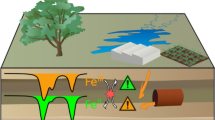Abstract
Variations in the nature of the bonding between iron and fulvic acid as a function of pH in sulfide-rich solutions have been investigated by 57Fe Mössbauer spectroscopy. In all solutions iron was enriched to 95% in the 57Fe isotope and ratios of Fe : fulvic acid were maintained at 1 : 100 on a weight basis for all measurements. When the pH was decreased below 5.0, there was a progressive change in the composition of the spectra, which contained three distinct components that were similar to those seen in the absence of sulfide; i.e., a sextet from magnetically-dilute Fe(III) and doublets from Fe(II) and Fe(III). There was, however, a higher proportion of the iron as Fe(II) in the sulfide-containing solutions and this represented the only form of iron at very low pH. Establishment of equilibria was slow as evidenced by considerable hysteresis between the compositions of the solutions with decreasing and increasing pHs. On increasing the pH, sulfide prevented the formation of magnetically dilute Fe(III) species and instead, in the range 3.5–6.0, compounds were generated with parameters consistent with sulfur being coordinated to the iron. One had parameters similar to those of pyrite and hence probably contains disulfide (S2 2−) units, whilst a second, with poorly defined magnetic hyperfine splitting, may contain monosulfide (S2−) units, with structures related to either pyrrhotite (Fe1−x S) or greigite (Fe3S4). A third component probably corresponds to a mononuclear low spin Fe(II) complex, involving sulfur and fulvic acid in the iron coordination sphere. These species were oxygen-sensitive and decomposed to yield magnetically dilute Fe(III) complexes and Fe(III) oxyhydroxides on aeration of the solutions.
Similar content being viewed by others
References
Freney, J. R. and Williams, C. H., In: M. V. Ivanov and J. R. Freney (eds), The Global Biogeochemical Sulphur Cycle, Scientific Committee on Problems of the Environment SCOPE 19, John Wiley & Sons, Chichester, 1983, p. 129.
Luther, III, G. W., Kostka, J. E., Church, T. M., Sulzberger, B. and Stumm, W., Marine Chemistry 40 (1992), 81.
Goodman, B. A., Cheshire, M. V. and Chadwick, J., J. Soil Sci. 42 (1991), 25.
Bloomfield, C. and Coulter, J. K., Adv. Agron. 25 (1973), 265.
Stevenson, F. J. and Fitch, A., In: P. M. Huang and M. Schnitzer (eds), Interaction of SoilMinerals with Natural Organics and Microbes, Soil Science Society of America Special Publication No. 17, 1986, p. 29.
Brown, K. A., Soil Biol. Biochem. 17 (1985), 39.
Morse, J. W., Millero, F. J., Cornwell, J. C. and Rickard, D., Earth Sci. Rev. 24 (1987), 1.
Goodman, B. A. and Cheshire, M. V., Sci. Total Environ. 62 (1987), 229.
Glentworth, R. and Muir, J. W., The Soils of the Country round Aberdeen, Inverurie and Fraserburgh, Memoirs of the Soil Survey of Scotland, HMSO, Edinburgh, 1963.
Stevens, J. G., Pollak, H., Zhe, L., Stevens, V. E., White, R.M. and Gigson, J. L., Mineral Data Handbook, Mössbauer Effect Data Center, University of North Carolina, 1983.
Huggins, F. E. and Huffman, G. G., In: Analytical Methods for Coal and Coal Products, Vol. III, Academic Press, 1979, p. 371.
Morra, M. J., Fendorf, S. E. and Brown, P. D., Geochim. Cosmochim. Acta 61 (1997), 683.
Farina, M., Esquivel, D. M. S. and Lins De Barros, G. P., Nature 343 (1990), 256.
Mann, S., Sparks, N. H. C., Frankel, R. B., Bazylinski, D. A. and Jannasch, H. W., Nature 343 (1990), 258.
Staniek, H., Fassbinder, J. W. E., Vali, Wägele, H. and Graf, W., Europ. J. Soil Sci. 45 (1994), 97.
Rickard, D. T., Stockholm Contrib. Geol. 20 (1969), 67.
Vaughan, D. J. and Ridout, M. S., J. Inorg. Nuclear Chem. 33 (1971), 741.
Berner, R. A., Amer. J. Sci. 268 (1970), 1.
Howarth, R. W., Science 203 (1979), 49.
Swider, K. T. and Mackin, J. E., Geochim. Cosmochim. Acta 53 (1989), 2311.
Coey, J. M. D., Spender, M. R. and Morrish, A. H., Solid State Commun. 8 (1970), 1605.
Kostka, J. E. and Luther, III, G. W., Geochim. Cosmochim. Acta 58 (1994), 1701.
Author information
Authors and Affiliations
Rights and permissions
About this article
Cite this article
Goodman, B.A., Cheshire , M.V. Characterisation by Mössbauer Spectroscopy of the Forms of Iron in Sulfide-Rich Fulvic Acid Solutions. Hyperfine Interactions 141, 549–558 (2002). https://doi.org/10.1023/A:1022415731470
Issue Date:
DOI: https://doi.org/10.1023/A:1022415731470




